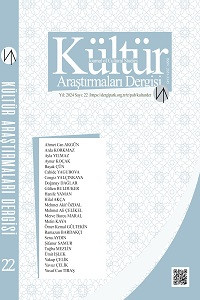Trans(inter?)textual Migrations (Relations?) in the Traditional (Postmodernist?) Narrative of Salman Rushdie
Abstract
Salman Rushdie's narrative style reflects a blend of traditional oral storytelling and postmodern literary techniques. This duality makes it challenging to categorize him strictly as either a traditional or postmodernist writer. His works, such as Midnight’s Children, exhibit fragmented storytelling akin to oral narratives, where the narrator frequently digresses, influenced by their environment and memories. These digressions create intertextual relationships, not just between texts but also between the text and the non-textual world, a technique which is called the "grasshopper narrative” in this paper. Rushdie's Midnight’s Children is heavily influenced by both Eastern oral traditions and Western literary techniques. The narrative is interspersed with references and borrowings from other texts and traditions, creating a tapestry of intertextual and trans-textual relations. For instance, characters and motifs from Forster’s A Passage to India and Kipling’s Kim find their way into Rushdie’s narrative, creating a dialogue between these works and Rushdie’s own. Moreover, the novel’s fragmented structure and the presence of a listener, Padma, enhance its oral storytelling feel, reinforcing its connection to traditional Eastern narratives. The influence of Western authors like Günter Grass and Gabriel García Márquez is also evident. These influences blend with Rushdie’s use of magic realism and his unique narrative style. Furthermore, Rushdie’s cinematic influences and his use of film vocabulary add another layer to his complex narrative structure. Rushdie’s narrative technique is a hybrid of traditional oral storytelling and postmodernist intertextuality, creating rich, multi-layered texts that traverse cultural and textual boundaries.
References
- Allen, Woody (1987). Three Films by Woody Allen: ‘Zelig’, ‘The Broadway Danny Rose’, ‘The Purple Rose of Cairo’. London & Boston: Faber & Faber.
- Cronin, Richard (1987). “The Indian English Novel: Kim and Midnight’s Children”. Modern Fiction Studies, 33(2): 202-203.
- Forster, E[dward] M. (1985). A Passage to India. Harmondsworth: Penguin.
- Goonetilleke, D. C. R. A. (1998). Salman Rushdie. London: Macmillan.
- Harrison, James (1992). Salman Rushdie. Ed. Kinley E. Boby. New York: Twayne Publishers.
- Jussawalla, Feroza (1996). “Rushdie’s Dastan-e-Dilruba: The Satanic Verses as Rushdie’s love letter to Islam”. Diacritics: A Review of Contemporary Criticism, 26(1): 50-73.
- Kortenaar, Neil (1997). “Postcolonial Ekphrasis: Salman Rushdie Gives the Finger Back to the Empire”. Contemporary Literature, 38(2): 232-259.
- Merivale, Patricia (1995). “Saleem Fathered by Oscar: Midnight’s Children, Magic Realism, and The Tin Drum”. Magical Realism: Theory, History, Community. Eds. Parkinson, Zamora & Faris. Durham & London: Duke University Press.
- Roy, Arundahti (1997). The God of Small Things. New York & London: Random House.
- Rushdie, Salman (1981). Midnight’s Children. London: Jonathan Cape.
- Rushdie, Salman (1982). “Salman Rushdie: Interview”. Kunapipi, 4(2).
- Rushdie, Salman (1983). Shame. London: Jonathan Cape.
- Rushdie, Salman (1988). The Satanic Verses. London: Viking Penguin.
- Rushdie, Salman (1989) “Choice Between Light and Dark”. Observer, 22 January 1989.
Abstract
Salman Rushdie'nin anlatı tarzı, geleneksel sözlü hikâye anlatımı ile postmodern edebi tekniklerin bir karışımını yansıtmaktadır. Bu ikilik, onu kesin olarak geleneksel ya da postmodernist bir yazar olarak kategorize etmeyi zorlaştırmaktadır. Geceyarısı Çocukları gibi eserleri, anlatıcının çevresinden ve anılarından etkilenerek sık sık konu dışına çıktığı sözlü anlatılara benzer şekilde, parçalı bir hikâye anlatımı sergiler. Bu sapmalar sadece metinler arasında değil, aynı zamanda metin ile metin dışı dünya arasında da metinler arası ilişkiler yaratır. Bu çalışmada, bu teknik “çekirge anlatıcı” olarak adlandırılmaktadır. Rushdie'nin Geceyarısı Çocukları hem Doğu sözlü geleneklerinden hem de Batı edebi tekniklerinden büyük ölçüde etkilenmiştir. Anlatı, diğer metinlerden ve geleneklerden yapılan göndermeler ve ödünç almalarla serpiştirilmiş, metinler arası ve metinler ötesi ilişkilerden oluşan bir goblen yaratılmıştır. Örneğin, Forster'ın A Passage to India ve Kipling'in Kim adlı eserlerindeki karakterler ve motifler Rushdie'nin anlatısına girerek bu eserler ile Rushdie'nin kendi eserleri arasında bir diyalog yaratır. Dahası, romanın parçalı yapısı ve Padma adında bir dinleyicinin varlığı, sözlü hikâye anlatımı hissini güçlendirerek geleneksel Doğu anlatılarıyla olan bağlantısını pekiştiriyor. Günter Grass ve Gabriel García Márquez gibi Batılı yazarların etkisi de açıkça görülüyor. Bu etkiler Rushdie'nin büyülü gerçekçilik kullanımı ve kendine özgü anlatım tarzıyla harmanlanır. Dahası, Rushdie'nin sinemasal etkileri ve kullandığı film terminolojisi karmaşık anlatı yapısına bir katman daha ekler. Rushdie'nin anlatı tekniği geleneksel sözlü hikâye anlatıcılığı ile postmodernist metinlerarasılığın bir karışımıdır ve kültürel ve metinsel sınırları aşan zengin, çok katmanlı metinler yaratmaktadır.
References
- Allen, Woody (1987). Three Films by Woody Allen: ‘Zelig’, ‘The Broadway Danny Rose’, ‘The Purple Rose of Cairo’. London & Boston: Faber & Faber.
- Cronin, Richard (1987). “The Indian English Novel: Kim and Midnight’s Children”. Modern Fiction Studies, 33(2): 202-203.
- Forster, E[dward] M. (1985). A Passage to India. Harmondsworth: Penguin.
- Goonetilleke, D. C. R. A. (1998). Salman Rushdie. London: Macmillan.
- Harrison, James (1992). Salman Rushdie. Ed. Kinley E. Boby. New York: Twayne Publishers.
- Jussawalla, Feroza (1996). “Rushdie’s Dastan-e-Dilruba: The Satanic Verses as Rushdie’s love letter to Islam”. Diacritics: A Review of Contemporary Criticism, 26(1): 50-73.
- Kortenaar, Neil (1997). “Postcolonial Ekphrasis: Salman Rushdie Gives the Finger Back to the Empire”. Contemporary Literature, 38(2): 232-259.
- Merivale, Patricia (1995). “Saleem Fathered by Oscar: Midnight’s Children, Magic Realism, and The Tin Drum”. Magical Realism: Theory, History, Community. Eds. Parkinson, Zamora & Faris. Durham & London: Duke University Press.
- Roy, Arundahti (1997). The God of Small Things. New York & London: Random House.
- Rushdie, Salman (1981). Midnight’s Children. London: Jonathan Cape.
- Rushdie, Salman (1982). “Salman Rushdie: Interview”. Kunapipi, 4(2).
- Rushdie, Salman (1983). Shame. London: Jonathan Cape.
- Rushdie, Salman (1988). The Satanic Verses. London: Viking Penguin.
- Rushdie, Salman (1989) “Choice Between Light and Dark”. Observer, 22 January 1989.
Details
| Primary Language | English |
|---|---|
| Subjects | British and Irish Language, Literature and Culture |
| Journal Section | Research Articles |
| Authors | |
| Publication Date | September 10, 2024 |
| Submission Date | June 3, 2024 |
| Acceptance Date | August 24, 2024 |
| Published in Issue | Year 2024 Issue: 22 |

